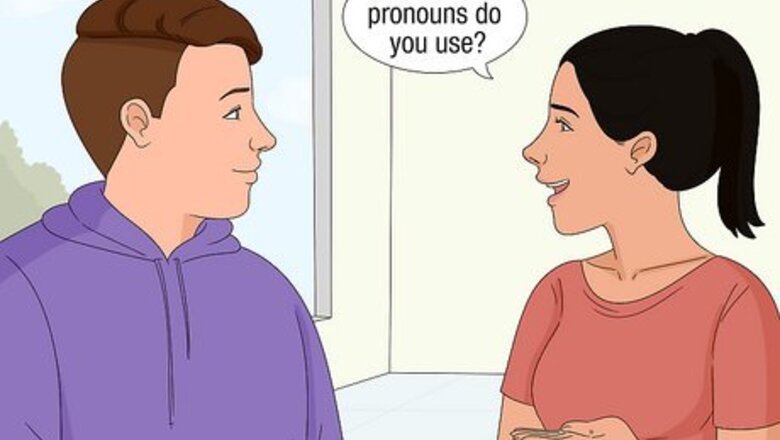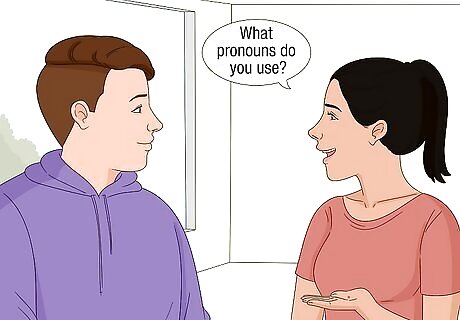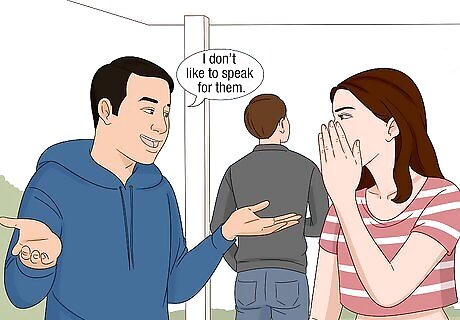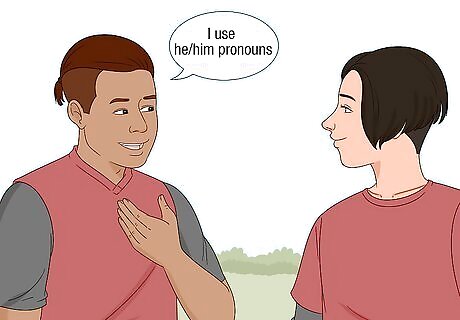
views
X
Trustworthy Source
Mayo Clinic
Educational website from one of the world's leading hospitals
Go to source
Not all trans or nonbinary people experience gender dysphoria, but if your friend is struggling, you can make a positive difference in their life.
Here are 11 ways you can be a good ally to a friend who is experiencing gender dysphoria.
Ask your friend what pronouns they use.

Stick to the correct pronouns when you talk about your friend. Trans women (people who were assigned male but identify as female) usually use she/her, and trans guys (people who were assigned female but identify as male) tend to use he/him. However, some people may use they/them or neo-pronouns (pronouns other than she/he/they). “Hey Jordan, what pronouns do you use?”
Tell your friend you support them and accept who they are.

Providing love and acceptance is a research-backed way to support LGBTQ+ people. Let your friend know you appreciate them and like spending time with them. Tell them why you like them and what their friendship means to you. In particular, make sure you let them know you care when they come out to you or are going through an emotional struggle. “I’m here for you. I care about you, and I’ll support you no matter what.” “I feel like you’re always there for me. You’re so kind and funny, and your friendship makes my life better every day. I want you to know I’m here for you, too.”
Correct yourself quickly if you misgender your friend.

Apologize politely and move on with the conversation. Misgendering your friend can mean using the wrong pronouns or referring to them by the wrong name. When it happens accidentally, just apologize without making a big deal of the situation (which can make your friend more uncomfortable) and use the correct pronouns. “I’m sorry. I meant ‘They’re going to the mall later.’” “Sorry, wrong name. Kenna, you should’ve gotten the chocolate ice cream.”
Keep your friend’s gender identity or dysphoria private.

Unless they tell you otherwise, don’t “out” your friend. Keep your friend safe and comfortable by letting them choose when to reveal their gender identity to other people. Ask if there are cases where your friend doesn’t want you to use the correct pronouns, since your friend may not be openly trans/non-binary in some places. By giving your friend time to come out on their own, you let them experience the freedom to be or find who they are, on their own terms. If you’re not sure who they’ve come out to, ask them: “I want to make sure I’m using the correct pronouns, but I also want to respect your privacy. Have you come out to the rest of our friends?” If someone speculates or asks about your friend, say: “I don’t like to speak for them. You can ask them directly if you’re curious about their gender.”
Listen to your friend and affirm their feelings.

Learn more about your friend’s experiences through active listening. Pay attention to what they’re saying, and let them know you hear them. If you're cisgender (meaning you identify with the gender you were assigned at birth), you might not be an expert on the issues your friend is facing, but you can validate how they feel. Always be ready to listen to them talk about their struggles and triumphs in discovering which gender identity feels right. “I hear what you’re saying, and that sounds exciting/tough/amazing/scary.” You can use brief verbal responses like “mm-hmm,” “I see,” “okay.” If you’re not sure how to respond, ask, “Can you tell me more about that?” or “How can I best support you?”
Introduce yourself with your pronouns to support your friend.

Say your pronouns to make that a normal part of greetings. Your friend might feel uncomfortable introducing themselves with their pronouns if no one else is doing it. When you give your own pronouns, it can both help your friend feel less isolated and model appropriate behavior for others. Add your pronouns after you introduce yourself, or you can even add pronouns to your social media profile, email signature, or video call meeting nametag. “Hi, I’m Zoe and I use she/her pronouns.” “It’s nice to meet you. I’m Karl and I use he/him pronouns.” “Hey, my name’s Denver and I use they/them pronouns.”
Use gender-inclusive language when you greet groups.

Pick words like “people,” “friends,” or “folks.” Change the way you greet others to make sure your friend feels included, and make gender-inclusive greetings a habit whether your friend is present or not. Referring to your friends or coworkers with gendered terms like “girls,” “boys,” “dudes,” “bros,” or “ladies” might make your friend with dysphoria feel uncomfortable. “Hi all, how are you doing?” “Hey, friends. Can we get going?” “Athletes/teammates, let’s huddle up.” You can never tell someone’s gender identity from looking at them, so you might unknowingly make another person feel more comfortable when you opt for gender-inclusive language.
Stand up for your friend when they're put in tough situations.

Ask the offending person to change their behavior or to leave. If the person is unintentionally using the wrong pronouns, let them know politely that they’re incorrect. If the person is openly harassing your friend, ask them to leave, and report their behavior if it poses a threat to your friend’s safety. Stepping in for your friend is one of the best ways you can support their health and wellbeing. “Actually, his name is Nick, and he uses he/him pronouns.” “Please leave. We’re not interested in talking to you.” Ask your friend before you intervene on their behalf. Your friend may not want you to speak for them. Ensure your intervention won’t escalate a conflict into violence or make your friend more uncomfortable/unsafe.
Advocate for all-gender accommodations in your community.

Demand inclusive bathrooms, locker rooms, and other signage. Encourage your school or workplace to designate single-stall or all-gender bathrooms via talking to an administrator, board, or creating a petition. Ask local businesses directly to put up gender-neutral signage. Participate in protests, lobbying, and support bills to push for all-gender bathrooms in your community.
Continue to educate yourself.

Seek out resources and information. Research the status of transgender and non-binary rights in your country. Listen to other gender nonconforming people’s stories, and learn about the different ways people can identify. As you keep learning, remember that it’s okay to admit what you don’t know! Understand that sexuality and gender are two different things. Know that there’s no right age or way for people to transition.
Support media created by trans and non-binary people.

Buy or view content that positively represents gender nonconforming people. Watch documentaries, listen to podcasts and music, and read books about the lives of people who have experienced gender dysphoria to become a better ally to your friend and others like them. At the same time, you get to support the broader gender nonconforming community by acting as an audience for a variety of important lived experiences.


















Comments
0 comment